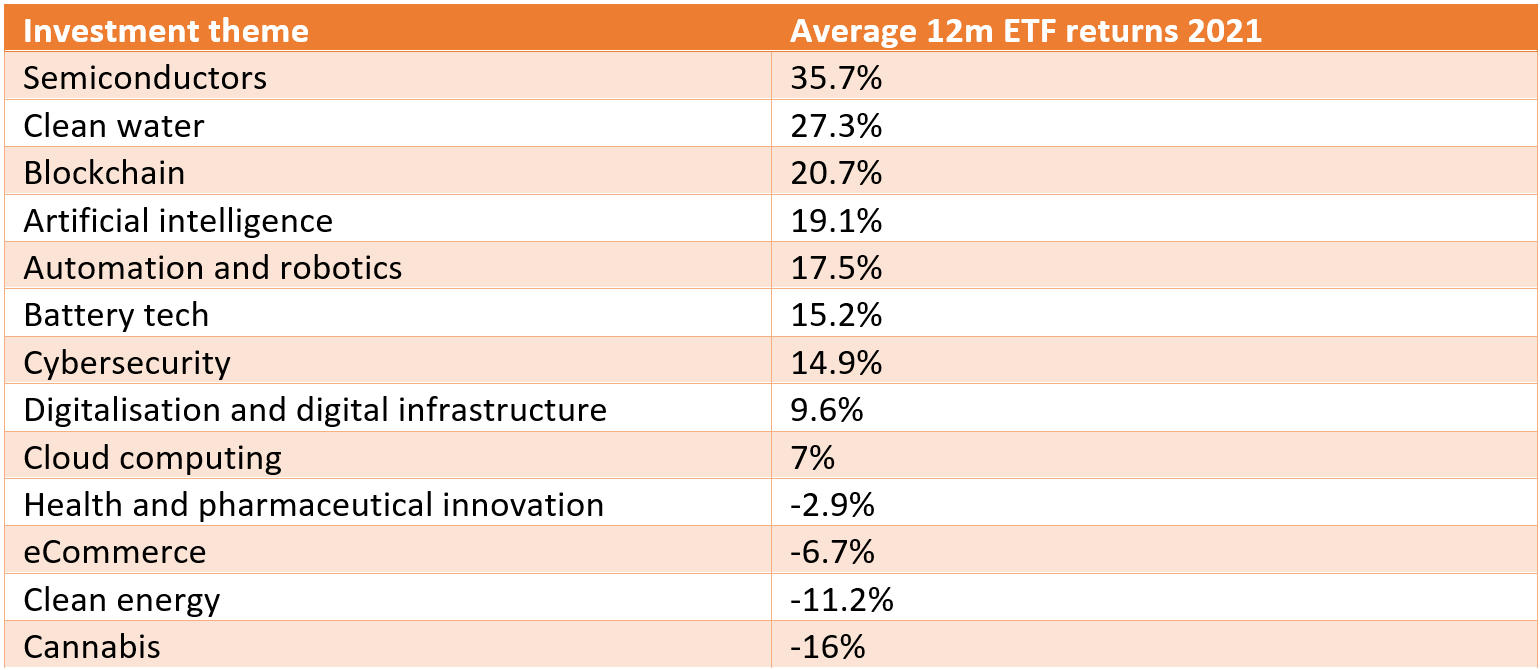Whether a tool for fad chasing or surgically targeting a structural trend, thematic ETFs have captured the imagination of less risk-averse investors and continue to evolve the wrapper beyond an instrument for cheap beta.
With the COVID-19 pandemic putting normal economic activity on hold, many began taking longer views on future industries driving global decarbonisation and digitalisation, as clearly evidenced by assets in thematic ETFs in Europe surging from $10bn at the end of 2019 to $41bn in the last month of 2021.
This snowball effect began in earnest in 2020 as lockdowns disrupted our traditional models for fossil fuel dependency and in-person work and socialising. While a ‘new normal’ began crystalising in 2021 – with economies reopening and a return to in-person interactions – the ongoing growth of thematic ETFs evidences continued investor interest in the megatrends set to play an increasingly important role in society.
However, though the height of pandemic volatility acted as a tide lifting most ‘new economy’ sectors, last year was different in that it compressed signals of a pandemic economy, recovery-stage economy and even a monetary tightening, early recession-stage economy into one 12-month period.
This resulted not only in massive performance dispersion within each thematic segment but also large disparities between different themes better and worse equipped to continue their early pandemic momentum.
Evidencing this, ETF Stream reveals the performance of each theme in 2021 based on the mean average 12-month returns of the three largest – if possible – ETFs in each segment.
1. Semiconductors
Perhaps surprising to some, the best-performing thematic ETF class in 2021 was the semiconductor industry which booked an average return of 35.7% across the two ETFs which have traded for over a year.
While many tech-related sectors suffered during the cyclical rotation in 2021, semiconductors continued apace as recovering manufacturing output drove demand for the chips which are a vital component in most modern goods and appliances. This demand was only squeezed by supply chain constraints, which saw semiconductor prices rise in line with the cyclical boost given to traditional commodities during market recoveries.
Benefitting most from this was Europe’s largest semiconductor ETF, the $857m VanEck Vectors Semiconductor UCITS ETF (SMGB), which surged 44.4%.
Also buoyed were the $73m Lyxor MSCI Semiconductors ESG Filtered UCITS ETF (TWNL), which rallied 27%, and the $214m iShares MSCI Global Semiconductor UCITS ETF (SEMI), which launched in August and booked 25.5% gains in the final three months of 2021.
2. Clean water
Next, a widely-praised theme within the ETF industry – clean water and water management – boasted average returns of 27.3%.
Clean water appeals to many due to its permanent use case, given societies have no choice but to invest in maintaining a consistent supply of water. The megatrend appealed last year, in particular, as US president Joe Biden committed $111bn to eliminate lead pipes and modernise drinking water, wastewater and stormwater infrastructure.
Leading the way in this theme was the largest ETF, the $2.9bn iShares Global Water UCITS ETF (IH20), which focuses broadly on the water industry and returned 30.4%.
Following behind was the $364m L&G Clean Water UCITS ETF (GLUG), which returned 26.2% with its tilt to innovative companies associated with increasing the supply of clean water. Finally, the broader $1.6bn Lyxor MSCI Water ESG Filtered UCITS ETF (WATL) boasted strong returns of 25.3%.
3. Blockchain
Riding the wave of cryptocurrency coverage and attention in 2021, blockchain ETFs averaged returns of 20.7% in a standout year.
Having far outstripped the thematic ETF pack for much of the year, blockchain equities waxed and waned with a high correlation to the performance of and media traction garnered by digital assets.
Falling from its high points during H1, the headline-grabbing $881m Invesco CoinShares Global Blockchain UCITS ETF (BCHN) still clocked impressive returns of 24% over the 12-month period.
Slightly behind was the $152m First Trust Indxx Innovative Transaction & Process UCITS ETF (LEGR), which booked 17.4%.
Finally, making an attention-grabbing entrance was the $2m ETC Group Digital Assets & Blockchain Equity UCITS ETF (KOIN), which launched in November and shot up 20.6% in December alone.
4. Artificial intelligence
Not far behind blockchain was another trend looked upon with equal measures of excitement and suspicion, artificial intelligence (AI), with ETFs targeting this theme averaging returns of 19.1%.
Buoyed by demand for more predictive or ‘intelligent’ technologies in computing, cybersecurity, advertising, transport and even homes and infrastructure, AI continues to be integrated into the daily functions of tech-enabled societies. AI services also continue to form larger parts of tech mega-caps, with the big five US tech companies having acquired a total of 76 AI firms between 2010 and June 2021, according to CB Insights.
Storming away from the rest of the AI pack in 2021 was the $498m Amundi STOXX Global Artificial Intelligence UCITS ETF (GOAI), returning 31.7%.
Next, Europe’s largest AI ETF, the $519m WisdomTree Artificial Intelligence UCITS ETF (WTAI), booked a 15.9% gain while the $333m L&G Artificial Intelligence UCITS ETF (AIAI) rose 9.8%.
5. Automation and robotics
Containing a strong overlap with AI, the automation and robotics theme returned an average of 17.5% in 2021.
Like AI, this segment benefits from ongoing interest in automated manufacturing processes, consumer appliances, military hardware and autonomous transportation. ETFs within the theme also have a strong crossover with other themes, including semiconductors, eCommerce and the broader tech sector, as automated products are used by an array of other subsectors.
A diversified and less exposure to the theme is offered by the massive $4.1bn iShares Automation & Robotics UCITS ETF (RBTX), which was also the strongest performed with returns of 22.3%.
Behind this, the $1.4bn L&G ROBO Global Robotics and Automation UCITS ETF (ROBO) jumped 15.7% while the $372m Lyxor MSCI Robotics & AI UCITS ETF (ROAI) rallied 14.4%.
6. Battery tech
Addressing the best-performing thematic categories involved in the decarbonisation economy was battery technology, with ETFs rising by an average of 15.2%.
While manufacturing activity recovered last year, few segments shot up faster than the demand for electric vehicles, with global EV purchases during H1 2021 hitting 2.65 million, up 168% on the comparable period a year earlier. This directly boosted companies in the battery value chain, who were only hampered by supply chain constraints.
Looking ahead, battery technology will play an increasingly important role in energy storage for electricity generated from intermittent sources, such as renewables.
Boasting an impressive gain of 17%, the $956m L&G Battery Value-Chain UCITS ETF (BATG) captures the entire supply chain, from metals miners to manufacturers and end retailers. The WisdomTree Battery Solutions UCITS ETF (VOLT) also fared well, with returns of 13.4%.
The battery ETF offering in Europe also widened in December with the arrival of the Global X Lithium & Battery Tech UCITS ETF (LITU), which amassed $4m in less than a month.
7. Cybersecurity
Only fractionally lagging were cybersecurity ETFs, with a mean average gain of 14.9%.
Individual headlines covering theft of company user information, NHS database hacks and China forcing firms to undergo cybersecurity checks prior to overseas IPOs ensure cybersecurity is constantly in the public eye. Its role will only increase as the ecosystem of online industries expands, including machine learning, Internet-of-Things (IoT), eCommerce, fintech and cloud tech, which could see its total value rise to $366bn by 2028, according to Fortune Business Insights.
Benefitting from the continued rise of this seemingly foundational sector was the $340m First Trust Nasdaq Cybersecurity UCITS ETF (CIBR) which returned 20.6%.
Hot on its heels was Europe’s largest cybersecurity ETF, the vast $3.1bn L&G Cyber Security UCITS ETF (ISPY), which returned 9.2%, while the $1.6bn iShares Digital Security UCITS ETF (LOCK) shot up 16.5%.
8. Digitalisation and digital infrastructure
A theme that targets the physical infrastructure needed to build out online and data capacity, digitalisation and digital infrastructure returned an average of 9.6% last year.
Digitalisation is a seemingly unstoppable tide. By January last year, there were more than 4.6 billion internet users globally, Statista found, with this number representing under 60% of the global population – leaving significant room for further expansion.
This headroom also does not account for the roll-out of new generations of connectivity innovation, such as 5G networks and new data centres, which require ongoing and global investment. For instance, last June Joe Biden pledged $65bn to modernise US broadband, internet and grid infrastructure.
The standout in this product class was the $34m HANetf Digital Infrastructure & Connectivity UCITS ETF (DIGI), which booked an impressive 18.5% gain.
Illustrating the degree of differentiation between similarly labelled products, the iShares Digitalisation UCITS ETF (DGTL) returned just 0.6% over the same period.
9. Cloud computing
Part of increasingly interconnected economies and even larger caches of on-demand data, cloud computing returned an average of 7% within thematic ETFs in 2021.
Most tech giants now have considerable cloud computing divisions, both for internal usage and also for on-demand virtual memory for users to store their data.
These interfaces allow users instant access to additional data storage capacity external to their personal or local hardware, with benefits including a secondary backup of important information as they transition between tech devices – though risks include hackers having access to millions of users’ personal data and media should they successfully breach a cloud network.
Illustrating another example of considerable dispersion, the $601m First Trust Cloud Computing UCITS ETF (FSKY) booked 12.3% and the $29m HANetf HAN-GINS Cloud Technology Equal Weight UCITS ETF (SKYY) recorded 10% gains while the $594m WisdomTree Cloud Computing UCITS ETF (KLWD) fell 1.4%.
Expanding its thematic range, Global X entered with its Global X Cloud Computing UCITS ETF (CLO) in November, which gathered $67m assets by the end of the year.
10. Health and pharmaceutical innovation
Moving into the negatively returning themes, health and pharma innovation returned an average of -2.9% last year.
With the largest ETF of this theme, the $2.1bn iShares Healthcare innovation UCITS ETF (HEAL), shooting up more than 50% in 2020, last year represented something of a reversion despite it being a 12-month period of continued innovation in the health and pharma industries.
HEAL took the biggest hit in the segment, falling 6.5%, while two products from Legal & General Investment Management (LGIM), the $213m L&G Healthcare Breakthrough UCITS ETF (DOCT) and the $33m L&G Pharma Breakthrough UCITS ETF (BIGT), rose 0.2% and shed 2.3%, respectively.
11. eCommerce
Suffering a similar fate was the e-commerce theme, with an average annual performance of -6.7%.
Having enjoyed a roaring 2020 on the back of unprecedented online retail activity, a slight comeback for in-person shopping, a reversion from lofty valuations and a China tech clampdown all proved costly for eCommerce.
Notably, this segment was the one with the greatest returns disparity – a colossal 52.5% – with ETFs targeting different parts of the eCommerce value chain experiencing starkly varied outcomes.
On the one hand, the $514m L&G Ecommerce Logistics UCITS ETF (ECOM) returned 19.6%. On the other hand, the $289m HANetf EMQQ Emerging Markets Internet & Ecommerce UCITS ETF (EMQQ) suffered a -32.9% knock.
Far from being a downturn confined to emerging markets, the $5m HANetf Global Online Retail UCITS ETF (IBUY) launched midway through the year and returned -30.1% in H2 2021.
12. Clean energy
Illustrating just how volatile the thematic landscape can be, clean energy went from a decade-long plateau, to triple-digit returns in 2020, to a mean average fall of 11.2% in 2021.
Primarily driven by an Icarus scenario, clean energy’s fall last year followed feverish speculative activity during the height of the pandemic, which was followed by a climbdown in lofty valuations and broad economic recoveries fuelled by traditional energy sources.
Leading this fall was the widely-covered $5.5bn iShares Global Clean Energy UCITS ETF (INRG), which dropped 24.2%, while the $130m L&G Clean Energy UCITS ETF (RENG) fell 6.2% and the $26m First Trust Nasdaq Clean Edge Green Energy UCITS ETF (QCLU) finished the year down 3.2%.
Having launched in March, the $46m Invesco Global Clean Energy UCITS ETF (GCLE) returned -12% in the second half of last year.
13. Cannabis
Having been one of the main thematic talking points following their arrival in early 2020, the ETFs making up the cannabis theme were some of 2021’s biggest casualties, falling by an average of 16%.
Starting the year on a strong footing following the election of Joe Biden, the appeal of some ‘meme’ stocks involved in cannabis diminished and warnings from the US Food and Drug Association (FDA) about “unclear and incomplete labelling” and the potential risks of cannabinoid delta-8 strain of THC saw stocks involved in the theme lose their shine.
Leading the losses was the larger of the two ETFs in the segment, the $41m Rize Medical Cannabis and Life Sciences UCITS ETF (FLWR), which fell 21.7%. Faring better but still in the red was the $36m HANetf The Medical Cannabis and Wellness UCITS ETF (CBDX), which returned -10.2%.

Emerging themes in 2021 and beyond
As well as being a year of notable returns, 2021 also showcased continued innovation within the ETF industry, with a host of new themes being targeted by wrapped products.
Among these were hydrogen, with the L&G Hydrogen Economy UCITS ETF (HTWO) and VanEck Vectors Hydrogen Economy UCITS ETF (HDRO) launching and amassing $561m and $100m in assets, respectively. Suffering a tough start to life, the two ETFs fell 12.1% and 15.3% in H2 2021.
Another burgeoning industry being addressed was the expanding fintech landscape. While investors had access to the $102m Invesco KBW NASDAQ Fintech UCITS ETF (FTEK), the $4m Rize Digital Payments Economy UCITS ETF (PMNT) and $16m L&G Digital Payments UCITS ETF (DPAY) launched in 2021, with the latter dropping 19.7% in the second half of last year.
Other honourable mentions go to Europe’s first wrapped products targeting crypto equities, the space industry and the continent’s first carbon-offset ETFs.
Looking ahead, investors interested in new thematic entrants ought to keep an eye on fashionable trends such as veganism and eco-friendly agriculture, the ‘metaverse’ and pressing demographic shifts such as the ageing population – which is currently underserved by ETFs.
Related articles












